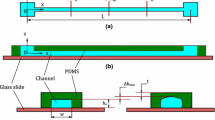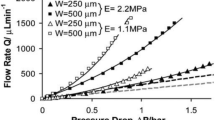Abstract
Microscale fluid dynamics has received intensive interest due to the emergence of Micro-Electro-Mechanical Systems (MEMS) technology. When the mean free path of the gas is comparable to the channel’s characteristic dimension, the continuum assumption is no longer valid and a velocity slip may occur at the duct walls. Non-circular cross sections are common channel shapes that can be produced by microfabrication. The non-circular microchannels have extensive practical applications in MEMS. Slip flow in non-circular microchannels has been examined and a simple model is proposed to predict the friction factor and Reynolds product fRe for slip flow in most non-circular microchannels. Through the selection of a characteristic length scale, the square root of cross-sectional area, the effect of duct shape has been minimized. The developed model has an accuracy of 10% for most common duct shapes. The developed model may be used to predict mass flow rate and pressure distribution of slip flow in non-circular microchannels.











Similar content being viewed by others
Abbreviations
- A :
-
flow area (m2)
- a :
-
major semi-axis of ellipse or rectangle (m)
- a :
-
base width of a trapezoidal or double-trapezoidal duct (m)
- b :
-
minor semi-axis of ellipse or rectangle (m)
- b :
-
height of a trapezoidal or double-trapezoidal duct (m)
- c :
-
half focal length of ellipse (m)
- c :
-
short side of a trapezoidal or double-trapezoidal duct (m)
- D h :
-
hydraulic diameter = 4A/P
- E(e):
-
complete elliptical integral of the second kind
- e :
-
eccentricity \(={{\sqrt{1 - {b^{2}} \mathord{\left/ {\vphantom {{b^{2}} {a^{2}}}} \right. \kern-\nulldelimiterspace} {a^{2}}}}}\)
- f :
-
Fanning friction factor \(={\tau /{\left({\tfrac{1}{2}\rho \bar{u}^{2}} \right)}}\)
- Kn :
-
Knudsen number \({=\lambda \mathord{\left/{\vphantom {\lambda {\ell}}} \right. \kern-\nulldelimiterspace} {\ell}}\)
- Kn * :
-
modified Knudsen number =Kn(2−σ)/σ
- L :
-
channel length (m)
- L + :
-
dimensionless channel length \({=L \mathord{\left/ {\vphantom {L {D_{h} {Re}}}} \right. \kern-\nulldelimiterspace} {D_{\rm h} {Re}}_{{D_{\rm h}}}}\)
- ℓ:
-
arbitrary length scale
- Ma :
-
Mach number = u/V s
- \({\dot{m}}\) :
-
mass flow rate (kg/s)
- P :
-
perimeter (m)
- Po :
-
Poiseuille number, \({={\bar{\tau}{\kern 1pt} {\ell}} \mathord{\left/ {\vphantom {{\bar{\tau}{\kern 1pt} {\ell}} {\mu {\kern 1pt} \bar{u}}}} \right. \kern-\nulldelimiterspace} {\mu {\kern 1pt} \bar{u}}}\)
- p :
-
pressure \({N \mathord{\left/{\vphantom {{\rm N} {{\rm m}^{2}}}} \right. \kern-\nulldelimiterspace} {m^{2}}}\)
- R :
-
specific gas constant \({J \mathord{\left/ {\vphantom {{\rm J} {{\rm kg}{\kern 1pt} K}}} \right. \kern-\nulldelimiterspace} {kg{\kern 1pt} K}}\)
- Re :
-
Reynolds number = \({{\ell}\bar{u}/\nu}\)
- r :
-
dimensionless radius ratio = r i /r o
- r i :
-
inner radius of a concentric duct (m)
- r o :
-
outer radius of a concentric duct (m)
- T :
-
temperature (K)
- U :
-
velocity scale (m/s)
- u :
-
velocity (m/s)
- \({\bar{u}}\) :
-
average velocity (m/s)
- V s :
-
speed of sound \({={\sqrt{\gamma RT}}}\)
- X n :
-
function of x/a
- x, y :
-
Cartesian coordinates (m)
- z :
-
coordinate in flow direction (m)
- α:
-
constants
- γ:
-
ratio of specific heats
- δ n :
-
eigenvalues
- ε:
-
aspect ratio =b/a
- η, ψ, z :
-
elliptic cylinder coordinates
- η0 :
-
parameter of elliptic cylinder coordinates
- λ:
-
molecular mean free path (m)
- μ:
-
dynamic viscosity \({{N{\kern 1pt} s} \mathord{\left/ {\vphantom {{{\rm N}{\kern 1pt} {\rm s}} {{\rm m}^{2}}}} \right. \kern-\nulldelimiterspace} {m^{2}}}\)
- ν:
-
kinematic viscosity (m2/s)
- σ:
-
tangential momentum accommodation coefficient
- τ:
-
wall shear stress \({{N{\kern 1pt}} \mathord{\left/ {\vphantom {{{\rm N}{\kern 1pt}} {{\rm m}^{2}}}} \right. \kern-\nulldelimiterspace} {m^{2}}}\)
- Φ:
-
half angle rad
- \({{\sqrt{A}}}\) :
-
based upon the square root of flow area
- c :
-
continuum
- D h :
-
based upon the hydraulic diameter
- i :
-
inlet
- ℓ:
-
based upon the arbitrary length ℓ
- o :
-
outlet
- E :
-
ellipse
- R :
-
rectangle
References
Araki T, Kim MS, Hiroshi I, Suzuki K (2000) An experimental investigation of gaseous flow characteristics in microchannels. In: Celata GP et al. (Ed) Proceedings of international conference on heat transfer and transport phenomena in microscale. Begell House, New York, pp 155–161
Arkilic EB, Breuer KS, Schmidt MA (1994) Gaseous flow in microchannels. Application of Microfabrication to Fluid Mechanics, ASME vol FED-197, pp 57–66
Arkilic EB, Breuer KS, Schmidt MA (1997) Gaseous slip flow in long microchannels. J Microelectromech Syst 6:167–178
Aubert C, Colin S (2001) High-order boundary conditions for gaseous flows in rectangular microducts. Microscale Thermophys Eng 5:41–54
Barber RW, Emerson DR (2006) Challenges in modeling gas-phase flow in microchannels: from slip to transition. Heat Transfer Eng 27:3–12
Choi SB, Barron RF, Warrington RO (1991) Fluid flow and heat transfer in microtubes. Micromech Sensors Actuators Syst ASME 32:123–134
Colin S, Lalonde P, Caen R (2004) Validation of a second-order slip flow model in rectangular microchannels. Heat Transfer Eng 25:23–30
Deisler RG (1964) An analysis of second-order slip flow and temperature-jump boundary conditions for rarefied gases. Int J Heat Mass Transfer 7:681–694
Duan ZP, Muzychka YS (2006) Slip flow in elliptic microchannels. Int J Thermal Sci (submitted)
Ebert WA, Sparrow EM (1965) Slip flow in rectangular and annular ducts. J Basic Eng 87:1018–1024
Ged-el-Hak M (2001) MEMS handbook. CRC Press, Boca Raton
Harley J, Huang Y, Bau H, Zemel JN (1995) Gas flows in micro-channels. J Fluid Mech 284:257–274
Karniadakis GE, Beskok A, Aluru N (2005) Microflows and nanoflows. Springer, Berlin Heidelberg New York
Liu J, Tai YC, Ho CM (1995) MEMS for pressure distribution studies of gaseous flows in microchannels. In: IEEE nternational conference on micro electro mechanical systems. Amsterdam, Netherlands, pp 209–215
Maurer J, Tabeling P, Joseph P, Willaime H (2003) Second-order slip laws in microchannels for helium and nitrogen. Phys Fluids 15:2613–2621
Morini GL, Lorenzini M, Spiga M (2005) A criterion for experimental validation of slip-flow models for incompressible rarefied gases through microchannels. Microfluidics Nanofluidics 1:190–196
Muzychka YS, Yovanovich MM (2002) Laminar flow friction and heat transfer in non-circular ducts and channels: part I-hydrodynamic problem. Compact Heat Exchangers, A Festschrift on the 60th Birthday of Ramesh K. Shah, Grenoble, pp 123–130
Nguyen NT, Wereley ST (2003) Fundamentals and applications of microfluidics. Artech House, London
Pfahler J, Harley J, Bau H, Zemel JN (1990) Gas and liquid transport in small channels. Microstruct Sensors Actuators ASME 19:149–157
Pfahler J, Harley J, Bau H, Zemel JN (1991) Gas and liquid flow in small channels. Micromech Sensors Actuators Syst ASME 32:49–58
Rohsenow WM, Choi HY (1961) Heat, mass, and momentum transfer. Prentice-Hall Inc., New Jersey
Schaaf SA, Chambre PL (1958) Flow of rarefied gases. Princeton University Press, New Jersey
Wu S, Mai J, Zohar Y, Tai YC, Ho CM (1998) A suspended microchannel with integrated temperature sensors for high pressure flow studies. In: Proceedings of IEEE workshop on micro electro mechanical systems. Heidelberg, Germany, pp 87–92
Acknowledgments
The authors acknowledge the support of the Natural Sciences and Engineering Research Council of Canada (NSERC).
Author information
Authors and Affiliations
Corresponding author
Rights and permissions
About this article
Cite this article
Duan, Z., Muzychka, Y.S. Slip flow in non-circular microchannels. Microfluid Nanofluid 3, 473–484 (2007). https://doi.org/10.1007/s10404-006-0141-4
Received:
Accepted:
Published:
Issue Date:
DOI: https://doi.org/10.1007/s10404-006-0141-4




